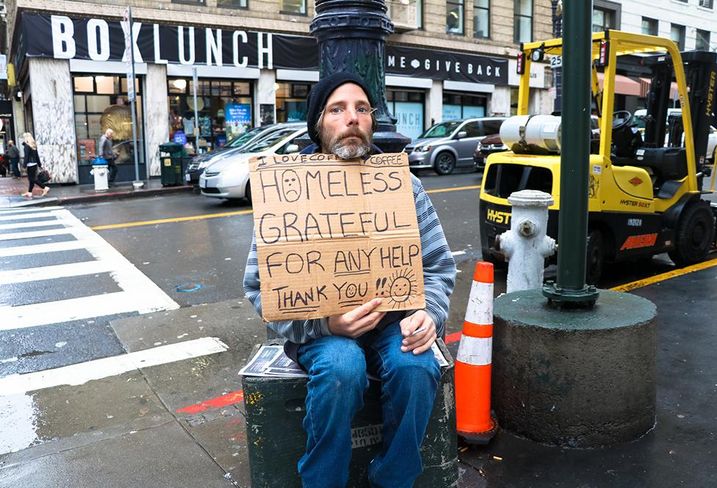But when people would visit I happily took them to all of the tourist stuff. My great-grandmother wanted to go on a trolley for the first time in her mid-90s so she flew out and we went. While I never agreed with the ban-happy politics - they were variously against golf, Happy Meals, and Jews in the early part of this century - it was a nice place by the time I arrived.
Now, it is more like a demilitarized zone, a 1980 version of a Frank Miller comic book set in New York City. The family and I went again this summer and the attendant in a very nice hotel felt the need to circle areas where we absolutely should not go. I knew what it meant; fentanyl junkies, and other homeless people crapping on the street. Or worse.

The fuzzy-wuzzy homeless person who's had bad luck and just needs a hand is the imagery that San Francisco politicians try to portray. The reality is what businesses and residents see, and it is not this nice. Credit: Flickr/Mussi Katz
The reason is simple. If you have a government who treats you like you're homeless through no fault of your own and compassionately throws services at you, or another that treats you like a vagrant, you go where people give you money. That is why nearly 50 percent of the country's homeless people have invaded a state that has just 10 percent of the population.
The new Council of Economic Advisers Report is just highlighting a crisis I've watched creeping ahead for 10 years. It isn't just San Francisco, three other cities in California (L.A., Santa Rosa, San Jose) are in the top five for homeless people nationwide. Seattle has always had a large homeless problem as well, which mystifies me. The weather is terrible compared to California. But they have money and are willing to spend it on hobos. Other states joining California and Washington with alarming numbers of homeless people are Oregon and Hawaii, while Washington, D.C. has the highest homeless rates in the country. We have an office there, they are everywhere. But all of those states and D.C. share one thing in common; their political skew.
The White House says it may come up with a plan to solve the crisis but it probably won't work for California. It is also easy for outsiders to say 'build more affordable housing' (even while Governor Gavin Newsom simultaneously plots to throw old people out of their homes using property taxes) but California is primarily a desert. You can't build more houses without a way to provide water and California environmentalists lobby against all water infrastructure. We haven't built a meaningful major water project since the state had half its population.
No water plan means no new buildings. And you probably don't want many of the modern homeless people suddenly living near you anyway, because it is not lack of employment that is their problem, it is mental illness and addiction to recreational drugs.
When Seattle recriminalized public urination and defecation in 1993 after 13 years of tourists being able to go anywhere without smelling it, a homeless group tried to spin it as homeless people were making “a political statement that there are not enough toilets” - Seattle just didn't spend enough - and San Francisco also undid its over-tolerance for crime, drugs, and public defecation in 1994, all of which led to the nice city I found when I moved to California in 1999. Now we have slipped back to the old ways.
In the real world, throwing money at services does no good if you don't penalize the homeless for not using them. San Francisco knew that two decades ago. Modern California needs a lot less Gsvin Newsom and a little more Pete Wilson.



Comments